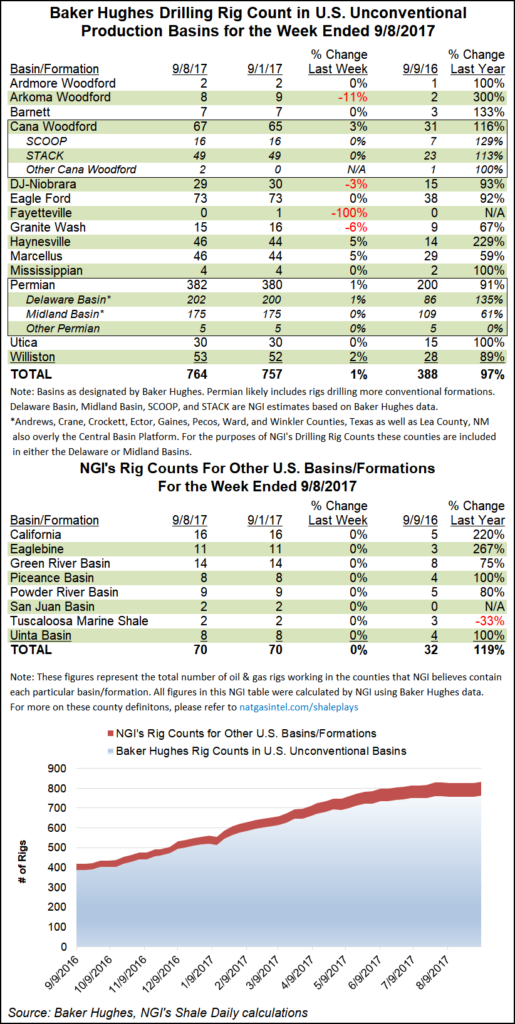Infrastructure | E&P | NGI All News Access
U.S. Adds Four NatGas Rigs, Drops Three Oil; Marcellus, Haynesville Lead Gains
The United States added four natural gas-directed rigs for the week ended Friday, offsetting a decline of three oil rigs to leave the combined domestic rig count up one at 944, according to data released by Baker Hughes Inc. (BHI).

In the United States, five directional rigs and one horizontal rig left the patch as seven vertical rigs returned, according to BHI.
Drilling activity in Canada held steady week/week; a lone oil rig returned to work to leave Canada up one at 202 rigs. That left the combined North American rig count at 1,146, up from 642 in the year-ago period.
The Marcellus and Haynesville shales have been running neck and neck recently, and the two natural gas giants led the gains for the week among plays, BHI data show. Both added two rigs to their tallies, and both finished at 46 rigs running at week’s end, compared with year-ago totals of 14 rigs in the Haynesville and 29 rigs in the Marcellus.
The outlook for Appalachian producers got a little brighter during the week, as the much-anticipated Rover Pipeline began service over the Labor Day weekend, ramping up to more than 600 MMcf/d of service from points near Cadiz, OH, to interconnects with ANR and Panhandle Eastern in northwestern Ohio.
The Cana Woodford and the Permian Basin also added two rigs each for the week, according to BHI. The Permian gains appeared to be focused in New Mexico, which continued its strong run recently by gaining three rigs to lead the states, according to BHI’s breakdown.
Losses for the week among plays included the Arkoma Woodford, the Niobrara-Denver Julesburg Basin and the Granite Wash, which each dropped one rig week/week. The Fayetteville Shale saw its lone rig pack up shop during the week and had no active units as of Friday, according to BHI.
North Dakota’s Williston Basin added a rig during the week to end at 53, up from 28 a year ago.

The Eagle Ford Shale, located in the path of Hurricane Harvey’s destruction, remained flat at 73 rigs, according to BHI. BHI said in the previous week’s rig count that it was unable to accurately assess the Eagle Ford due to Harvey, but after an extra week to assess the damage, it appears Eagle Ford drilling activity has been resilient.
Eagle Ford producers have begun detailing the production impacts from Harvey after the storm forced them to shutter operations the week before. Super independent ConocoPhillips said this week that its Eagle Ford output was approaching 80% of its pre-storm level of 130,000 b/d. Chesapeake Energy Corp. CEO Doug Lawler said during a conference this week that the exploration and production company still had about 20% of its production offline in the field.
Since a recent high of 958 rigs running for the week ended July 28, the U.S. rig count has now fallen by 14, with the losses focused in Texas (down seven), Oklahoma (down six) and Louisiana (down seven). California (three), Mississippi (two), New Mexico (seven), Ohio (two) and West Virginia (one) have each gained rigs since July 28.
U.S. drillers have added four vertical rigs during that timeframe while dropping one directional rig and 17 horizontal units, an NGI analysis of BHI data shows.
BHI said Friday the U.S. rig count averaged 947 for the month of August, down from 953 averaged for July. The average rig count in August 2016 was 481, BHI said.
BHI said its international rig count for the month of August finished at 952, down seven month/month but up 15 from 937 counted in the year-ago period.
The worldwide rig count in August averaged 2,116 versus 2,110 in July and 1,547 counted in August 2016, BHI said.
© 2024 Natural Gas Intelligence. All rights reserved.
ISSN © 2577-9877 | ISSN © 2158-8023 |
